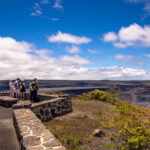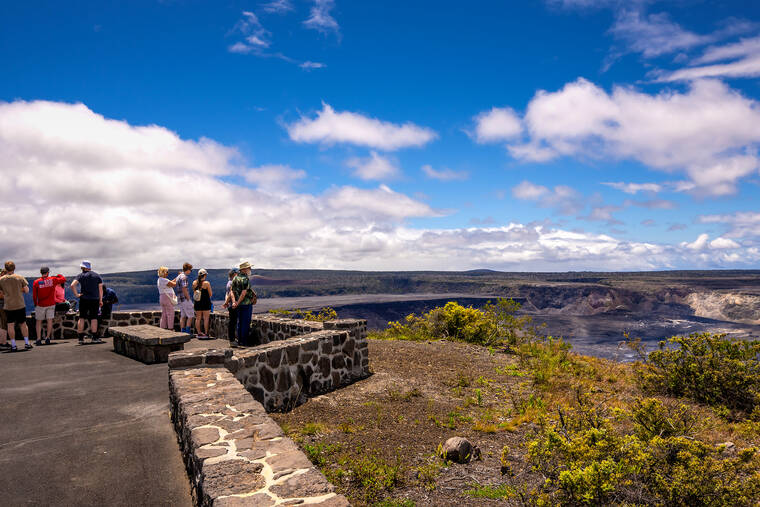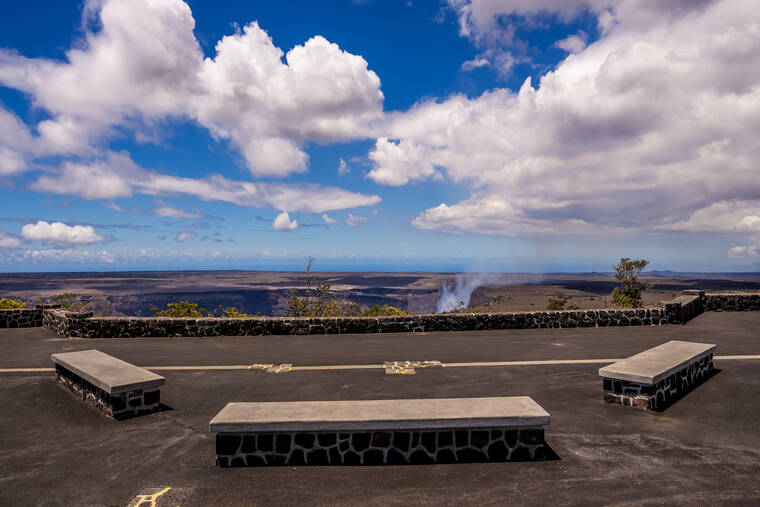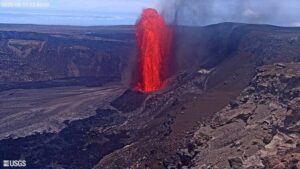Kilauea summit lookout reopens for the first time since 2018


An observation deck on Kilauea volcano’s summit that provides panoramic views of the caldera and Halema‘uma‘u crater has reopened in Hawaii Volcanoes National Park.
The observation deck area, known as Uekahuna, is the highest point on Kilauea and is steeped in centuries of Hawaiian tradition. From that spot, visitors can look across the caldera and into the ever-changing crater, gaze upslope to the summit of Mauna Loa, and watch koa‘e kea (white-tailed tropicbirds) soar above the crater walls.
ADVERTISING
The reopening of Uekahuna gives HNVP visitors another good spot from which to watch Kilauea’s on-again, off-again eruption, which began in late December and has since had 23 “episodes” of high lava-fountaining, with the most recent one ending Sunday.
Uekahuna has been closed since May 2018, following two large earthquakes, a catastrophic eruption and summit collapse that triggered thousands of smaller earthquakes over a four-month period.
The park’s historic Jaggar Museum and two buildings used by the USGS Hawaiian Volcano Observatory were badly damaged and removed. Deconstruction began in April 2024 and is now complete.
Although the buildings are gone, the observation deck and historic stone walls — once crumbling and riddled with fractures from the 2018 earthquakes — have been repaired.
An outline of the former Jaggar Museum footprint includes stones from the original columns to commemorate the historic building. And a new HVO field station is being built near the historic ballfield by Kilauea Military Camp, further away from the rim of the caldera.
“We are delighted to welcome everyone back to Uekahuna,” HVNP Superintendent Rhonda Loh said in a press release. “We deeply appreciate how understanding the community and park visitors have been during the construction process, and mahalo those who provided feedback on the options.”
A new path now connects the observation deck to Crater Rim Trail along the rim of the caldera, and the area has been replanted with native shrubs, grasses and trees near the observation deck. A historic stone bench was restored, and several new benches that replicate the historic look have been added.
The restrooms and comfort station at Uekahuna will reopen once the new water tank is complete and passes inspection, which is projected for later this summer, according to HVNP.
Uekahuna is deeply revered by generations of Native Hawaiians who were the first to observe and interpret the volcanic processes within Kaluapele (Kilauea caldera) and an important site for western science ever since Dr. Thomas A. Jaggar founded the Hawaiian Volcano Observatory in 1912.
Jaggar Museum will not be rebuilt. Instead, the renovated Kilauea Visitor Center will accommodate the lost visitor services provided at the museum.
Kilauea Visitor Center is slated to reopen by summer 2026.
Park officials urge visitors to stay behind the stone walls and post-and-cable barriers at Uekahuna and elsewhere along the caldera rim for their safety.
Steep and unstable cliff edges along Kaluapele drop approximately 500 feet to the crater floor.






